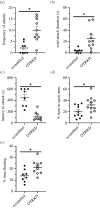Oxytocin interactions with central dopamine and serotonin systems regulate different components of motherhood
- PMID: 35858105
- PMCID: PMC9272149
- DOI: 10.1098/rstb.2021.0062
Oxytocin interactions with central dopamine and serotonin systems regulate different components of motherhood
Abstract
The role of oxytocin in maternal caregiving and other postpartum behaviours has been studied for more than five decades. How oxytocin interacts with other neurochemical systems to enact these behavioural changes, however, is only slowly being elucidated. The best-studied oxytocin-neurotransmitter interaction is with the mesolimbic dopamine system, and this interaction is essential for maternal motivation and active caregiving behaviours such as retrieval of pups. Considerably less attention has been dedicated to investigating how oxytocin interacts with central serotonin to influence postpartum behaviour. Recently, it has become clear that while oxytocin-dopamine interactions regulate the motivational and pup-approach aspects of maternal caregiving behaviours, oxytocin-serotonin interactions appear to regulate nearly all other aspects including postpartum nursing, aggression, anxiety-like behaviour and stress coping strategy. Collectively, oxytocin's interactions with central dopamine and serotonin systems are thus critical for the entire suite of behavioural adaptations exhibited in the postpartum period, and these sites of interaction are potential pharmacological targets for where oxytocin could help to ameliorate deficits in maternal caregiving and poor postpartum mental health. This article is part of the theme issue 'Interplays between oxytocin and other neuromodulators in shaping complex social behaviours'.
Keywords: dopamine; dorsal raphe; oxytocin; serotonin; ventral tegmental area.
Figures






Similar articles
-
Serotonin-specific lesions of the dorsal raphe disrupt maternal aggression and caregiving in postpartum rats.Behav Brain Res. 2018 Aug 1;348:53-64. doi: 10.1016/j.bbr.2018.04.008. Epub 2018 Apr 10. Behav Brain Res. 2018. PMID: 29653128 Free PMC article.
-
Decreased mesolimbic dopaminergic signaling underlies the waning of maternal caregiving across the postpartum period in rats.Psychopharmacology (Berl). 2020 Apr;237(4):1107-1119. doi: 10.1007/s00213-019-05441-7. Epub 2020 Jan 11. Psychopharmacology (Berl). 2020. PMID: 31927604
-
The role of oxytocin in shaping complex social behaviours: possible interactions with other neuromodulators.Philos Trans R Soc Lond B Biol Sci. 2022 Aug 29;377(1858):20210058. doi: 10.1098/rstb.2021.0058. Epub 2022 Jul 11. Philos Trans R Soc Lond B Biol Sci. 2022. PMID: 35858107 Free PMC article. Review.
-
Oxytocin receptor expression in the midbrain dorsal raphe is dynamic across female reproduction in rats.J Neuroendocrinol. 2021 Feb;33(2):e12926. doi: 10.1111/jne.12926. Epub 2021 Jan 11. J Neuroendocrinol. 2021. PMID: 33427399
-
Adaptations in reward-related behaviors and mesolimbic dopamine function during motherhood and the postpartum period.Front Neuroendocrinol. 2020 Apr;57:100839. doi: 10.1016/j.yfrne.2020.100839. Epub 2020 Apr 16. Front Neuroendocrinol. 2020. PMID: 32305528 Free PMC article. Review.
Cited by
-
Chronic Pain and Comorbid Emotional Disorders: Neural Circuitry and Neuroimmunity Pathways.Int J Mol Sci. 2025 Jan 7;26(2):436. doi: 10.3390/ijms26020436. Int J Mol Sci. 2025. PMID: 39859152 Free PMC article. Review.
-
Monoamine neurochemistry, behavior, and microhabitat contribute to male coquí frog modes: silent, territorial, and paternal.J Comp Physiol A Neuroethol Sens Neural Behav Physiol. 2025 May;211(3):293-309. doi: 10.1007/s00359-025-01732-x. Epub 2025 Feb 5. J Comp Physiol A Neuroethol Sens Neural Behav Physiol. 2025. PMID: 39909908
-
Gestational stress disrupts dopamine and oxytocin signaling in the postpartum reward system of rats: implications for mood, motivation and mothering.Sci Rep. 2025 Jan 9;15(1):1450. doi: 10.1038/s41598-024-84043-6. Sci Rep. 2025. PMID: 39789137 Free PMC article.
-
The Role of Oxytocin and Vasopressin in Drug-Induced Reward-Implications for Social and Non-Social Factors.Biomolecules. 2023 Feb 21;13(3):405. doi: 10.3390/biom13030405. Biomolecules. 2023. PMID: 36979340 Free PMC article. Review.
-
When Your Body Tells You to Not Breastfeed-The Connivance of Oxytocin, Prolactin, and Dopamine.Int J Mol Sci. 2025 Jun 19;26(12):5909. doi: 10.3390/ijms26125909. Int J Mol Sci. 2025. PMID: 40565372 Free PMC article. Review.
References
Publication types
MeSH terms
Substances
Grants and funding
LinkOut - more resources
Full Text Sources

